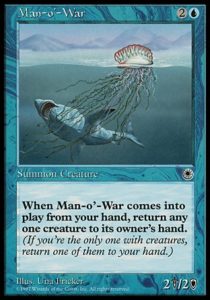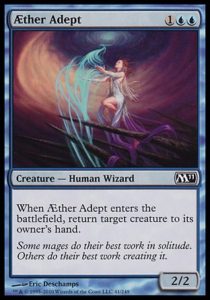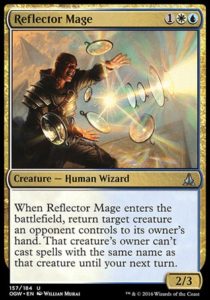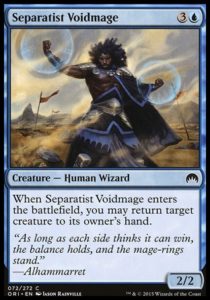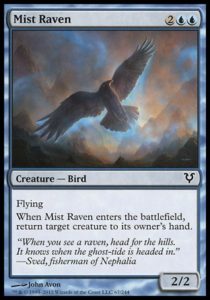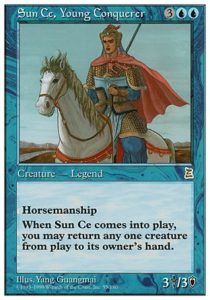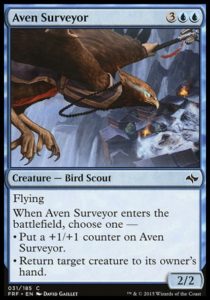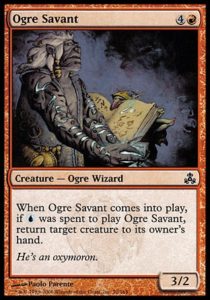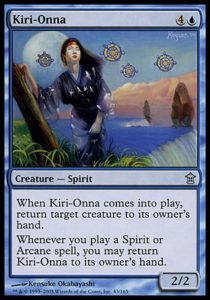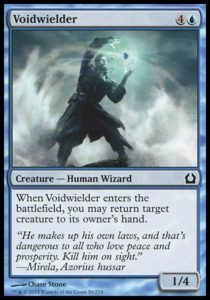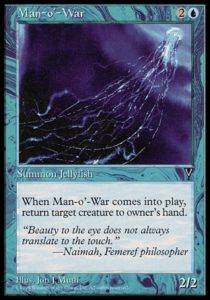This Friday, Eternal Masters comes out, and it heralds the return of the original Man-o-’War—Man-o-’War. It’s a card that is unimpressive in every individual way yet substantially more than the sum of its parts. No one is really excited to play a Gray Ogre. Unsummon isn’t a stellar removal spell, and it’s one that involves trading away card advantage (one of blue’s most treasured possessions) for tempo (something which blue at the time of Visions didn’t really care about). However, staple ‘em together and brilliance happens.
Man-o’-War is a fantastic, simple design. It has squared stats, which are easy to parse. It has one ability that’s spelled out completely and briefly. It effectively has no text once its enter the battlefield trigger resolves. It’s one of my favorite blue creatures, which is saying something, since I’m terrified of jellyfish in real life—though if we’re really splitting hairs, a Portuguese Man-o’-War isn’t really a jellyfish, as it’s not a single muticellular organism. Frankly, it only has one flaw, and that’s a consequence of how cards were templated back in ’96: if the battlefield is empty, it reads 2U: increase your storm count by 1. However, that’s how cards were made back then: if you didn’t want every part of the animal, then why was put in your deck in the first place?
Man-o’-War is the inspiration behind a slew of bouncing creatures, the progenitor of a deep vein of design space—along with its good friends, Uktabi Orangutan and Nekrataal, who inspired different kinds of ETB creatures. Creatures like Sunscape Master, Echo Tracer, Skymark Roc, and Mistblade Shinobi follow in the foosteps of the humble jellyfish from Visions.
However, this article isn’t about those cards; it’s about every direct descent of Man-o’-War. Waterfront Bouncer and Tradewind Rider are certainly powerful, but they don’t bounce a creature when they enter the battlefield. Same goes for Barrin, Master Wizard and Linessa, Zephyr Mage. Surrakar Banisher, Selkie Hedge-Mage, Lumengrid Drake, Murk Strider, and the out-of-color Stingscourger all have conditions on what and when they can bounce. This article is dedicated the far less numerous direct descendants of the cnidarian from Jamuura and what they tell us about the upcoming bonkers common in EMA.
Magic 2011 and 2012’s Aether Adept is the closest thing we’ve had to a true, monoblue Man-o’-War. It has substantially better creature types—human and wizard are both supported by a wealth of cards while there are only eight jellyfish in Magic, none of which interact with each other, excluding changelings and Mistform Ultimus—and an appreciably worse mana cost. It is a ‘must’ ability, just like Man-o’-War‘s, an oddity in both modern templating and core sets. It coexisted with insane Limited removal spells like Lightning Bolt and Doom Blade, and like them, was cycled out after common removal spells were weakened in Innistrad. It has not been in Standard since, but perhaps Aether Revolt will see it return (without the Æ ligature).
Reflector Mage is one of the best blue creatures in Standard, and it’s not surprising why: it sacrifices the ability to bounce your own creatures for a point of toughness, the reliability that you’ll never have to bounce your own stuff, and banning a card for a whole turn cycle. While Aether Adept is definitively worse than Man-o’-War (excluding its tribal relevance and favorable interaction with Thassa, God of the Sea and Master of Waves), Reflector Mage is the only creature in Magic that threatens to be an upgrade to the O.G. bouncer.
Voidmage Separatist is an excellent acknowledgement of Man-o’-War‘s power level: if you increase its cost by one (and make its ‘must’ ability a ‘may,’ a minor but appreciable upgrade), it’s still one of blue’s best common creatures.
Frankly, it’s more reasonably costed than its forebear: when you staple two effects together, the combined card tends to cost more than the sum of its parts. A vanilla 2/2 tends to cost two (though blue doesn’t get those at common), and an Unsummon costs U, so the combination of both should cost more than 2U. That said, costing four rather than three obviously has a negative effect. If you cast a Man-o’-War on turn three on the draw, you can bounce your opponent’s three-drop creature and likely trade for their two-drop. You’re doing well on tempo, and if you’re on the play, you’re in great position to attack. If you cast Voidmage Separatist on turn four on the play, you can make the same line, but if you cast it on the draw, a 2/2 may be too puny to block your opponent’s three-drop. All said, Voidmage Separatist is an excellent example of how a single mana can dramatically change a card.
Ah, Mist Raven, the best common in Avacyn Restored. While Innistrad worked quite well with weakened removal, Avacyn Restored was all the worse for it. Without strong interaction, most games devolved into races, and I think we all know what kind of creature excels at both applying pressure and improving your board presence relative to your opponent’s. Mist Raven is a clear combination of two cards: either Man-o’-War and Flight or Wind Drake and Unsummon. Either way you slice it, it’s a stellar creature and the final Man-o’-War that costs less than five mana.
A 3/3 flying for 5 used to be amazing, now it’s just fine (and tends to have an upside, like flash or vigilance). However, Aven Surveyor was a 3/3 a small percentage of the time. Most often, it was to Mist Raven what Voidmage Separatist was to Man-o’-War: a mana more expensive, but still one of blue’s best common creatures.
With Sun Ce, Young Conquerer, you get to have both sides of Aven Surveyor, with super flying! It’s almost certainly the most powerful Man-o’-War that costs five mana, but it’s also likely the least played one, given how rarely Portal Three Kingdoms was drafted or is available.
These are the last three Man-o’-Wars. Voidwielder was a top tier common in Return to Ravnica. Ogre Savant (an honorary blue card) was one of the best common creatures in Guildpact. Kiri-Onna… I’m assuming was decent in Saviors of Kamigawa Limited, a format I’ve played once and not loved. They all demonstrate that you can almost double the cost of Man-o’-War with little upside and still have a solid creature.
If you haven’t played much with Man-o’-War, or you simply haven’t though about why it’s so awesome, perhaps this article has given you some insight into all the minutae of what makes that legendarily awesome Magic jellyfish so spectacular.
So, there you have it. That’s the history of every Man-o’-War and an explanation of why the original is so bonkers, as well as how nuts it’ll be as a common in Eternal Masters.
Now, I imagine a small number of you folks are a tad miffed that I didn’t include all the ETB bouncers. Indeed, I excluded five creatures that bounce more than just other creatures: Riftwing Cloudskate, Aethersnipe, Dinrova Horror, Urborg Emissary, and last but certainly not least, Venser, Shaper Savant. Why? Well, I wanted to focus as closely as I could to Man-o’-War‘s design, plus I didn’t want this article to go on forever. If you’d love to read more about the history Boomerang and why it’s a broken effect, well, we can do that another day. Until then, thanks for reading (as always), and if you’re so fortunate, enjoy Eternal Masters! I know I will.
—Zachary Barash
Zachary Barash has been playing Magic on and off since 1994. He loves Limited and drafts every available format (including several that aren’t entirely meant to be drafted). He’s a proud Cube owner, improviser, and game designer (currently going for an MFA in Game Design at NYU). He has an obsession with Indian food that borders on being unhealthy.

